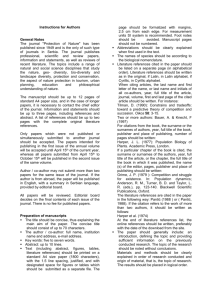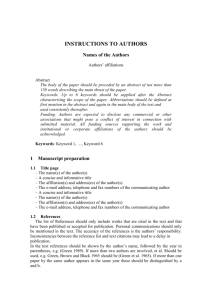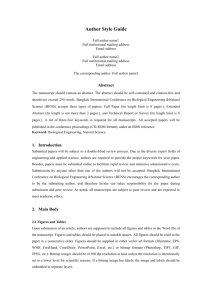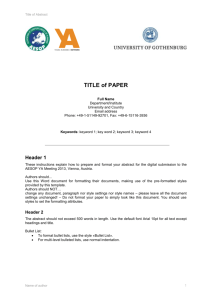APA Guidelines
advertisement
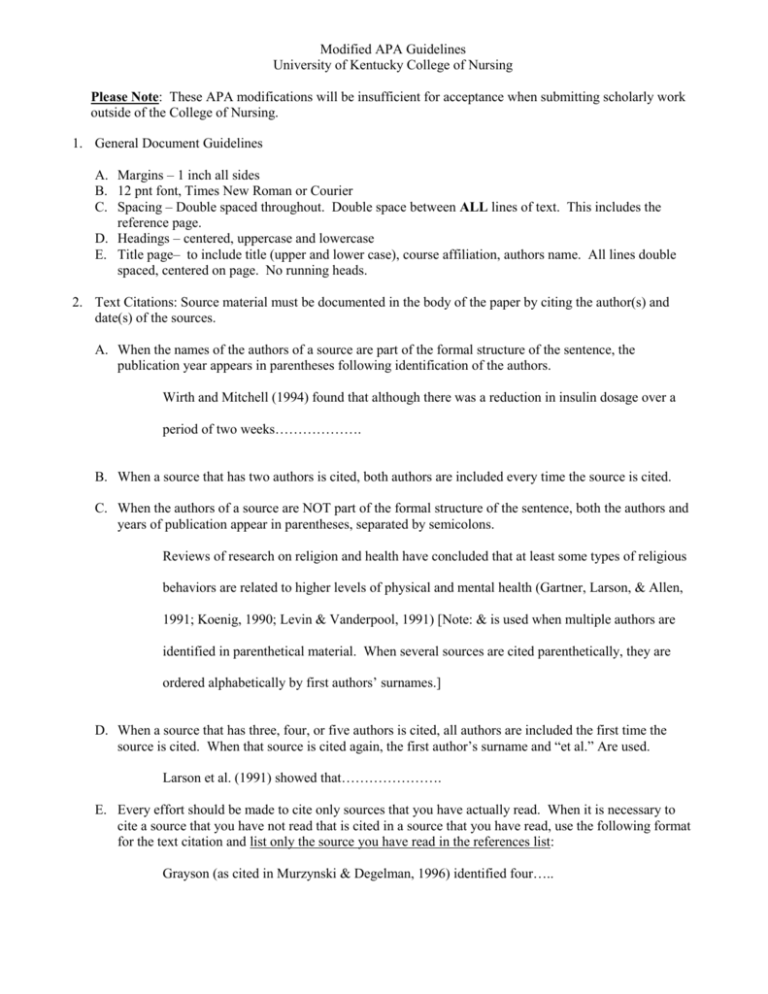
Modified APA Guidelines University of Kentucky College of Nursing Please Note: These APA modifications will be insufficient for acceptance when submitting scholarly work outside of the College of Nursing. 1. General Document Guidelines A. Margins – 1 inch all sides B. 12 pnt font, Times New Roman or Courier C. Spacing – Double spaced throughout. Double space between ALL lines of text. This includes the reference page. D. Headings – centered, uppercase and lowercase E. Title page– to include title (upper and lower case), course affiliation, authors name. All lines double spaced, centered on page. No running heads. 2. Text Citations: Source material must be documented in the body of the paper by citing the author(s) and date(s) of the sources. A. When the names of the authors of a source are part of the formal structure of the sentence, the publication year appears in parentheses following identification of the authors. Wirth and Mitchell (1994) found that although there was a reduction in insulin dosage over a period of two weeks………………. B. When a source that has two authors is cited, both authors are included every time the source is cited. C. When the authors of a source are NOT part of the formal structure of the sentence, both the authors and years of publication appear in parentheses, separated by semicolons. Reviews of research on religion and health have concluded that at least some types of religious behaviors are related to higher levels of physical and mental health (Gartner, Larson, & Allen, 1991; Koenig, 1990; Levin & Vanderpool, 1991) [Note: & is used when multiple authors are identified in parenthetical material. When several sources are cited parenthetically, they are ordered alphabetically by first authors’ surnames.] D. When a source that has three, four, or five authors is cited, all authors are included the first time the source is cited. When that source is cited again, the first author’s surname and “et al.” Are used. Larson et al. (1991) showed that…………………. E. Every effort should be made to cite only sources that you have actually read. When it is necessary to cite a source that you have not read that is cited in a source that you have read, use the following format for the text citation and list only the source you have read in the references list: Grayson (as cited in Murzynski & Degelman, 1996) identified four….. 3. Quotations: When a direct quotation is used, always include the author, year, and page number as part of the citation. A. A quotation of fewer than 40 words should be enclosed in double quotation marks and should be incorporated into the formal structure of the sentence. Patients receiving prayer had “less congestive heart failure, required less antibiotic therapy, had fewer episodes of pneumonia, had fewer cardiac arrests, and were less frequently intubated and ventilated” (Byrd, 1988, p. 839). B. A lengthier quotation of 40 or more words should appear (without quotation marks) apart from the surrounding text, in block format, with each line indented five spaces from the left margin. When quoting, always provide the author, year, and specific page citation in the text. Miele (1993) found the following: The placebo effect, which had been verified in previous studies, disappeared when behaviors were studied in this manner. Furthermore, the behaviors were never exhibited again, even when real drugs were administered. Earlier studies (e.g. Abdullah, 1984; Fox, 1979) were clearly premature in attributing the results to a placebo effect. (p. 276). 4. References A. The first line of all references are aligned at the left margin, with each subsequent line indented 5 spaces. B. All entries are organized alphabetically by surnames of first authors C. Authors are listed in the same order as specified in the source, using surnames and initials. Commas separate all authors. If no author is identified, the title of the document begins the reference. D. Year of publication: In parentheses following authors, with a period following the closing parenthesis. If no publication date is identified, use “n.d.” in parentheses following the authors. E. Source Reference: Include title, journal, volume, pages (for journal article) or title, city of publication, publisher (for book). Italicize titles of books, titles of periodicals, and periodical volume numbers. F. Examples of sources 1. journal article Murzynski, J., & Degelman, D. (1996). Body language in women and judgments of vulnerability to sexual assault. Journal of Applied Social Psychology, 26, 1617-1626. 2. Book Paloutzian, R.F. (1996). Invitation to the psychology of religion (2nd ed.). Boston: Allyn and Bacon. 3. Stand alone web document, no date Degelman, D., & Harris, M.L. (n.d.). APA style essentials. Retrieved May 18, 2000, from http://www.vanguard.edu/faculty/ddegelman/index.cfm?doc_id=796 4. Stand alone web document, no date/author Gender and Society. (n.d.). Retrieved December 31, 2001, from http://www.trinity.edu/~mkearl/gender.html 5. Journal article from database Hien, D., & Honeyman, T. (2000). A closer look at the drug abuse-maternal aggression link. Journal of Interpersonal Violence, 15, 503-522. Retrieved May 20, 2000, from ProQuest database, 6. Article or chapter in an edited book Shea, J.D. (1992). Religion and sexual adjustment. In J. F. Schumaker (Ed.), Religion and Mental Health (pp. 70-84). New York: Oxford University Press. 7. Web page http://www.apastyle.org/elecgeneral.html For examples of electronic reference formats go to: http://www.apastyle.org/elecref.html For examples of APA-formatted references go to: http://www.vanguard.edu/psychology/references.pdf For an example of a complete article formatted according to APA style, go to http://www.vanguard.edu/psychology/prayer.pdf
